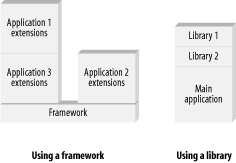1.6 What Is a Framework?
| I have been using the term framework in this chapter without having defined what exactly it is, or how it adds value in software development. In its simplest form, a framework is a set of classes and interfaces that cooperate to solve a specific type of software problem. A framework has the following characteristics:
A good framework should provide generic behavior that many different types of applications can make use of. There are many interpretations of what constitutes a framework. Some might consider the classes and interfaces provided by the Java language a framework, but these are really a library. There's a subtle, but very important, difference between a software library and a framework. A software library contains functions or routines that your application can invoke. A framework, on the other hand, provides generic, cooperative components that your application extends to provide a particular set of functions. The places where the framework can be extended are known as extension points. A framework commonly is referred to as an "upside-down" library because of the alternate manner in which it operates. Figure 1-5 illustrates the subtle differences between frameworks and software libraries. Figure 1-5. A framework and a library are not the same thing 1.6.1 Creation of the Struts FrameworkThe Struts framework was created by Craig R. McClanahan and donated to the ASF in 2000. Craig is deeply involved in the expert groups for the Servlet and JSP specifications and wrote a large portion of the Tomcat implementation. He also speaks at various conferences, including JavaOne and ApacheCon. Several committers[3] have joined the Struts project, and even more developers have volunteered their time and effort to improve it and increase its value. As a result, the framework has gone through several beta releases and a few general availability (GA) releases, and although many new features have been added, the framework hasn't strayed far from its core ideas.
1.6.2 Contribution to the Struts ProjectThe Struts group always welcomes new participants. To become a contributor, it's recommended that you first join the Struts User mailing list. If you like what you see there, take a look at the Struts Developers mailing list. This is the best way to get started and become familiar with the direction of the project. You should read the mailing list guidelines, at http://jakarta.apache.org/site/mail.html, before joining. You can then join one or more of the Jakarta Project's mailing lists, including those for Struts, from the URL http://jakarta.apache.org/site/mail2.html. The main project web site for Struts is located at http://jakarta.apache.org/struts/. For more information on downloading and installing Struts, see Appendix B. |
EAN: 2147483647
Pages: 180